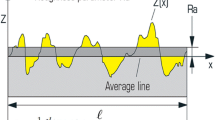Abstract
Face milling is extensively used machining operation to generate the various components. Usually the selection of the process parameters are incorporated by trial and error method, literature survey and the machining hand book. This kind of selection of process parameters turns out to be very tedious and time-consuming. In order to overcome this there is a need to develop a technique that could be able to find the optimal process parameters for the desired responses in machining. The present paper illustrates an application of response surface methodology (RSM) and particle swarm optimization (PSO) technique for optimizing the process parameters of milling and provides a comparison study among desirability and PSO techniques. The experimental investigations are carried out on metal matrix composite material AA6061-4.5%Cu-5%SiCp to study the effect of process parameters such as feed rate, spindle speed and depth of cut on the cutting force, surface roughness and power consumption. The process parameters are analyzed using RSM central composite face-centered design to study the relationship between the input and output responses. The interaction between the process parameters was identified using the multiple regression technique, which showed that spindle speed has major contribution on all the responses followed by feed rate and depth of cut. It has shown good prediction for all the responses. The optimized process parameters are acquired through multi-response optimization using the desirability approach and the PSO technique. The results obtained from PSO are closer to the values of the desirability function approach and achieved significant improvement.




Similar content being viewed by others
Abbreviations
- AMMCs:
-
Aluminium metal matrix composites
- ANOVA:
-
Analysis of variance
- ANN:
-
Artificial Neural Network
- CCFCD:
-
Central composite face-centered design
- CNC:
-
Computer numerical control
- DOE:
-
Design of experiment
- GA:
-
Genetic algorithm
- MMC:
-
Metal matrix composite
- RSM:
-
Response surface methodology
- PSO:
-
Particle swarm optimization
- RCCD:
-
Rotatable central composite design
- FX:
-
Cutting force, N
- Ra:
-
Surface roughness, µm
- Gbest:
-
Global best
- pbest:
-
Particle best
- R-sq:
-
Pre R-squared
- R-sq(adj):
-
Adj R-squared
References
Shettigar A, Salian G, Herbert M, Rao S (2013) Microstructural characterization and hardness evaluation of friction stir welded composite AA6061-4.5Cu-5SiC (Wt%). Def Sci J 63(4):429–434
Reddy SK, Kwang-Sup S, Yang M (2008) Experimental study of surface integrity during end milling of Al/SiC particulate metal–matrix composites. J Mater Process Technol 20I:574–579
Baji D, Lela B, Živković D (2008) Modeling of machined surface roughness and optimization of cutting parameters in face milling. Metallurgy 474:331–334
Yoon HS, Lee JY, Kim MS, Kim ES, Ahn SH (2014) Empirical study of the power efficiency of various machining processes. Procedia CIRP 14:558–563
Haber R, Alique JR, Press CR (1996) Fuzzy supervisory control of end milling process. Inf Sci 89:95–106
Haber RE, Alique JR (2007) Fuzzy logic-based torque control system for milling process optimization. IEEE Trans Syst Man Cybern Part C Appl Rev 37:941–950
Wong SV, Hamouda AMS (2003) Machinability data representation with artificial neural network. J Mater Process Technol 138:538–544
Benardos PG, Vosniakos GC (2002) Prediction of surface roughness in CNC face milling using neural networks and Taguchi’s design of experiments. Robotics Comput Integr Manuf 18:343–354
Choudhury IA, El-Baradie MA (1997) Surface roughness prediction in the turning of high-strength steel by factorial design of experiment. J Mater Process Technol 67(1–3):55–61
Dimla DE (2002) The correlation of vibration signal features to cutting tool wear in a metal turning operation. J Adv Manuf Technol 19:705–713
Radhkrishnan T, Nandan U (2005) Milling force prediction using regression and neural networks. J Intell Manuf 16(1):93–102
Zain AM, Haron H, Sharif S (2009) Application of GA to optimize cutting conditions for minimizing surface roughness in end milling machining process. Expert Syst Appl 37:4650–4659
Ab Rashid MFF, Gan SY, Muhammad NY (2009) Mathematical modeling to predict surface roughness in CNC milling. In: Proceedings of world academy of science, engineering and technology, 41, ISSN: 2070-3740
Ciurana J, Arias G, Ozel T (2009) Neural network modeling and particle swarm optimization (PSO) of process parameters in pulsed laser micromachining of hardened AISI H13 steel. J Mater Manuf Process 24(3):358–368
Lee TS, Lin YJ, Ting O (2007) An investigation of grinding process optimization via evolutionary algorithms. In: Proceedings of the IEEE swarm intelligence symposium, IEEE computer society, Washington, DC, USA, 176–181, ISBN:1-4244-0708-7
Kim T-Y, Woo J, Shin D, Kim J (1999) Indirect cutting force measurement in multi-axis simultaneous NC milling processes. Intl J Mach Tools Manuf 39:717–1731
Derringer G, Suich R (1980) Simultaneous optimization of several response variables. J Qual Technol 12(4):214–219
Eberhart CR, Kennedy J (1995) Particle swarm optimization. In Proceedings of IEEE international conference on neural networks piscataway, NJ, pp 1942–1948
Phadke MS (1989) Quality engineering using robust design. Prentice Hall, New Jersey
Ross PJ (1996) Taguchi techniques for quality engineering. McGraw-Hill, New York
Montgomery DC (2008) Design and analysis of experiments. Wiley, New York
Rai R, Kumar A, Rao S, Shriram D (2010) Development of a surface roughness prediction system for machining of hot chromium steel (AISI H11) based on artificial neural network. ARPN J Eng Appl Sci 5(11):53–59
Reddy SK, Rao PV (2006) Selection of an optimal parametric combination for achieving a better surface finish in dry milling using genetic algorithms. Intl. J Adv Manuf Technol 28:463–473
Author information
Authors and Affiliations
Corresponding author
Additional information
Technical Editor: Márcio Bacci da Silva.
Rights and permissions
About this article
Cite this article
Malghan, R.L., Rao, K.M.C., Shettigar, A. et al. Application of particle swarm optimization and response surface methodology for machining parameters optimization of aluminium matrix composites in milling operation. J Braz. Soc. Mech. Sci. Eng. 39, 3541–3553 (2017). https://doi.org/10.1007/s40430-016-0675-7
Received:
Accepted:
Published:
Issue Date:
DOI: https://doi.org/10.1007/s40430-016-0675-7




